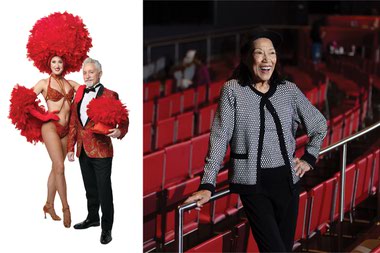
When the Rain Stops Falling Through November 13; Thursday-Saturday, 8 p.m.; Saturday & Sunday, 2 p.m.; $20-$25. 100 S. Maryland Parkway, apublicfit.org.
When the Rain Stops Falling, the latest from A Public Fit Theatre Company, works in a high formal register, painting an elegiac portrait of a family struggling with secrets and sins. It’s a slow burn of a play that, in the hands of co-directors Ann Marie Pereth and Joseph Kucan, makes for a symphony of loss.
Written by Andrew Bovell, the play takes place over four generations, from 1950s through the 2030s. It has a very Gabriel Garcia Márquez tone to it, with its magical realist trappings: It’s seemingly raining all the time, in every era; it has looping language and imagery; and its characters search to subvert their fates, while simultaneously falling prey to them. Pereth and Kucan push the non-literal in their staging, whether that’s introducing the ensemble through movement sequences involving soup and Magritte-inspired tableaux with umbrellas, or turning chairs into gravestones and tables into Australia’s Uluru. They’re aided by Eric A. Koger’s set, a simple foreground platform located downstage of a portal made of an intricate set of webbing, with a deep, deep upstage section that allows characters to enter from (and leave into) a deep pool of darkness.
The actors live up to their side of things, too. Christopher Brown is fabulous portraying Henry Law and Gabriel York, bookending fathers in this saga. The two characters are unreliable narrators, and Brown brings a fragile, attack-and-retreat quality to them both. Mike Rasmussen plays a son searching for a father, his open face displaying frustrations, hurt and hope, the soul of a Romantic quest. The women of the cast are given harder tasks, with two sets of two actresses portraying two characters at two different stages of their lives: Valerie Carpenter Bernstein and Tina Rice as the older and younger Elizabeth Law, respectively, and Jane C. Walsh and Jamie Carvelli-Pikrone as the older and younger Gabrielle York. All the actresses brought sharpness to their roles—desperation and hope, leavened with a bitter taste of betrayal.
Not all was perfect. The accents—a mix of English and Australian as the play changed locations—got mixed or dropped at times. And the staging around the set made it difficult to know where we were in the action, taking me away from the characters and language as I paused to put the pieces together. I also would have liked to see more ties between the younger and the older female characters—both in a physicality between the actresses and in sharper costuming from Mariya Radeva-Nedyalkova.
Still, in the “entertainment capital of the world,” it’s rare to see theater that works in this register—a show that unabashedly and skillfully aims to create a serious work of art that’s challenging, cerebral and emotionally impacting. It’s satisfying in ways that go beyond just a good show, which this assuredly is.







